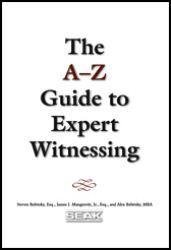The need for expert witnesses has never been greater than it is today. Litigants rely on expert witness testimony in the vast majority of all civil cases. Unfortunately, few experts receive formal training in such subjects as the expert’s proper role in the legal system; how to communicate opinions effectively at deposition, at trial, and in a written report; the law and procedure dealing with expert witnesses; ethics; how to deal with attorneys; and how to better manage the business aspects of a forensic practice. This book has been written to provide information in all of these areas. It is the comprehensive A–Z resource for all expert witnesses.
The authors have illustrated the points made in this work by example. They have included 540 examples in the twenty-four chapters of this book. Each example contains a summary headnote and many contain comments from the authors. In addition, there are lengthier examples and model documents in the twenty-six appendices. Many of the examples are summaries of actual court decisions. These are provided to give context to the principles discussed in this book as examples of how certain issues have been resolved by a court in the jurisdiction in question (always keeping in mind that different jurisdictions may handle similar situations differently). This book is in no way intended to give legal advice to the reader. Substantive and procedural law vary from jurisdiction to jurisdiction. Experts should consider seeking professional legal advice regarding any particular legal issue that may arise from their own forensic practices.
The chapters in this book are grouped together in the following categories: procedure (2–4), evidence (5), qualifications (6–7), forming and expressing opinions (8–10), expert testimony (11–15), expert witness practice management (16–20), and additional topics (21–24).
Excerpted from the SEAK text, The A-Z Guide to Expert Witnessing

